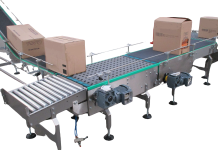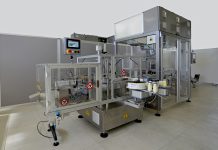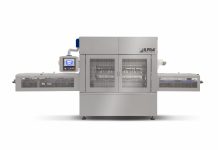The new marking and coding solutions for the food and beverage industry focus on meeting customers’ requests in terms of productivity, costs optimization and reliability. For the new labels, make way for eco-compatibility and safety.
The sector of food technologies is continuously changing: production lines grow ever more complex, and packaging is constantly changing. The marking technologies for the food and beverage sector need to adjust to modern production lines, reaching higher and higher speeds, and designed to optimise the marking process irrespective of the processed material (PET, aluminium, glass, metal, paper, board, plastic, etc.) or of the package (cans, boxes, bottles, bags, cases, trays, or pallets, etc.). Latest solutions are designed to adjust to all processing speeds, ranging from 60,000 to 120,000 pieces per hour, without compromising the quality of the marking, in order to obtain high-resolution, high-contrast prints. Savings in ownership costs still remains one of the main issues to attract new customers. Standard solutions cannot meet all needs and address all issues of a complex and varied sector as that of the food industry. So this is why the companies developing marking and coding technologies are devising solutions specifically designed for each individual need. The major issues are: adjustments to the speed of the production lines; higher line efficiency; reduction of total ownership costs in general; marking process control by means of dedicated software. As for the adjustment to the speed of production lines, the companies offer high-contrast, high-resolution prints even in the case of a high number of packages (120,000 packs/hour with ink-jet technology, and 100,000 packs/hour with laser technology); application of perfectly readable bar codes, Data Matrix and serialization of any kind of secondary package operating at different speeds according to the kind of implemented technology (hot-melt inks or print&apply). More efficient and flexible lines are requested, offering the possibility of handling packages of different sizes irrespective of the speed, quick and safe changes of formats and materials, without losses and without stopping the marking process. Great attention is devoted also to the management of real-time display of a variety of operations, as printing autonomy, continuous consumptions control, servicing intervals, and so on. All plusses aimed to cut rather than to increase operating costs, even by reducing the possibility of human errors by means of a software durable printing heads, optimal colour and ink management, longer time periods between servicing interventions, limited energy consumption. Always with a view to reducing costs, marking and coding modules must be of compact design for a simple integration on packaging lines; they must be equipped with longer cables for a practical and quick connection and/or disconnection, and, last but not the least, they must be suitable for adaptation to present and future production needs by simply adding or replacing standard components. Integration with the company’s WMS system (Warehouse Management System)/ERP (Enterprise resource planning) is increasingly required. For high-speed and high-coverage applications, the market offers coding and marking equipment fitted with inkjet modules not requiring a cooling station, thus eliminating the problem of the shrinkage of printed material caused by high temperatures. All this thanks to high-density inks and to the reduced amount of energy used in the drying process. They ensure low cost of ownership (TCO – Total Cost of Ownership), thanks to lower ink and additives consumption; optimised servicing and extremely lo energy consumption.
Quick drying inks
It is worth spending a few words on new printing inks that dry fast when they are cast over the carrier to be printed, with or without MEK, and that guarantee excellent readability even in case of high-speed printing. These inks reproduce high-contrast codes irrespective of the substrate material: aluminium cans; PET bottles; paper board boxes; yoghurt jars; metal or plastic caps; paper labels. Next to their quick drying property, they do not alter their properties, they are formulated to withstand water and steam at high temperatures when containers are filled or sealed; and they withstand low storage temperatures in refrigerators and freezers as well as to the abrasions caused by the direct contact of the products when they are stacked or conveyed along the production line. Furthermore, they offer excellent adhesion on most plastic materials that are usually difficult to print, as untreated polyethylene and polypropylene, as well as on metals, paper, wood, ceramics and glass.





